|
The following is a list of the viola species we saw last April 21st on our
expedition to the Dunbar Hills in Southwest Pennsylvania. It is strictly the
work of an amateur (myself) and thought I would divide them according to
flower color.
|
| Blue |
|
1. |
Viola sororia (common blue violet) |
| |
|
|
|
|
| |
| |
 |
| Viola
sororia |
|
|
| |
When I first learned violet names, our common blue (stemless) violet was
V. papilionacea. It was smooth, and there was a hairy Midwestern species
called V. sororia that I had never seen. Then, some years ago it was
decided that hairy or smooth does not make any difference, does not make a
species, so the two were put together and called V. sororia. I am sorry
they used that name because V. papilionacea is much prettier.
A number of other violets that used to be considered separate species; V.
septentrionalis for instance, have also been lumped with V.
sororia.
Probably 95% of what you see will be V. sororia, and you can just assume
any little blue violet is V. sororia unless there is something really
different about it. It will still be called V. papilionacea in older
books. White forms of V. sororia are very commonly seen, as is the
beautiful variety Priceana or 'Confederate' violet. 'Freckles' is also a
color variant of V. sororia. |
|
|
2. |
Viola hirsutula (southern wood violet) |
|
|
|
|
|
| |
| |
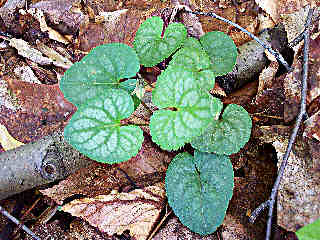 |
| Viola
hirsutula |
|
|
| |
This is one we saw on the mountain, not down by the creek, and it is one
of our most beautiful violets, with dark purple (not blue) flowers and
leaves that are silver on top (because of being covered with white hairs)
and purplish on the bottom. This is a woodland species and not really
common but not rare either. |
|
|
3. |
Viola sagittata (arrow-leaved violet) |
|
|
|
|
|
| |
| |
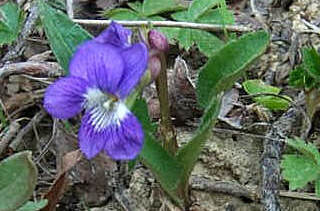 |
| Viola
sagitata -f- sagitata |
|
|
| |
This is the violet that caused so much discussion in the afternoon in the
field and after dinner. There used to be three somewhat similar species,
with blue flowers and leaves that are longer than wide, sagittate or
arrowhead-shaped leaves. V. sagittata was smooth and had lobes at the base
of the leaf. V. fimbriatula was hairy, had lobes at the base of the leaf
and was found in rocky, exposed places. V. emarginata had triangular
leaves. Now all of them have been lumped together as V. sagittata, and
Harvey Ballard has two varieties, (1) variety sagittata that is mostly
smooth with long leaf stems that stand up, and (2) variety ovata (the
former V. fimbriatula) that is hairy and has leaves with short stems that
are flat to the ground. |
|
|
4. |
Viola rostrata (long-spurred violet) |
|
|
|
|
|
| |
| |
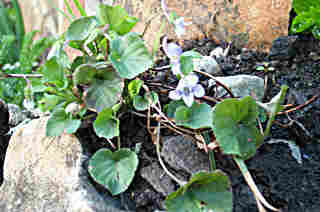 |
| Viola
rostrata |
|
|
| |
This is the only stemmed blue violet we saw and it is easy to recognize
because of its long spur. It is usually a lighter blue than most violets.
The 'Dog violet' is similar but the spur is not as long. |
|
|
|
|
|
| White |
|
5. |
Viola blanda (sweet violet)
The only white one we saw. |
|
|
|
|
|
| |
| |
 |
| Viola
blanda |
|
|
| |
It is a very small stemless violet and is usually found in damp places. It
often has red stems on both leaves and flowers and often the two top
petals are twisted back. It is called sweet violet because it is sometimes
scented, but I don't often find it scented. Last week Gary Sherwin sent us
an E-mail saying that violets had indeed bloomed at Dunbar Creek and he
included some pictures. The picture of V. blanda blooming in the moss was
a perfect illustration of the species. |
|
|
|
|
|
| Yellow |
|
6. |
Viola pubescens (stemmed yellow, downy yellow
violet) |
|
|
|
|
|
| |
| |
 |
| Viola
pubescens |
|
|
| |
There used to be two stemmed yellow violets. One was downy yellow, V.
pubescens, and one was smooth yellow, V. pennsylvanica. As with
V.
papilionacea and V. sororia above, it was decided that these were really
only one species that could vary from smooth to downy. There were some
other characteristics said to belong to one or the other species, but I
had almost never found a plant that totally conformed to the description
of either V. pubescens or V. pensylvanica so I was happy to have them
together as one. The problem here is not recognizing this species but what
to call it. First the name of V. pennsylvanica was changed to V.
eriocarpa,
and the two together were V. eriocarpa with a downy variety called var.
pubescens. Now it is V. pubescens with the downy variety pubescens and the
smooth variety scabriuscula. |
|
|
|
|
|
|
7. |
Viola rotundifolia (round-leaved violet) |
|
|
|
|
|
| |
| |
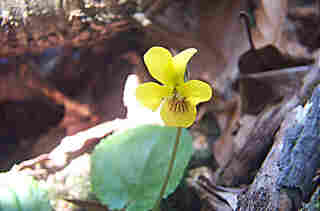 |
| Viola
rotundifolia |
|
|
| |
This is an easy one. It's the earliest to bloom, two or three weeks before
the others. It is a stemless yellow and has very round leaves held close
to the ground. When the plant blooms, the leaves are fairly small but they
get much bigger in summer. It is the only stemless yellow violet in the
east. |
|
|
|
|
|
|
8. |
Viola hastata (halberd-leaved violet) |
|
|
|
|
|
| |
| |
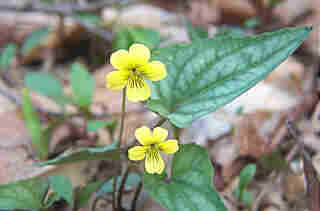 |
| Viola
hastata |
|
|
| |
This is another easy yellow. It is stemmed but can't be confused with V.
pubescens or anything else because it has beautiful triangular, pointed
leaves that are silver-patterned. I wish this violet had a prettier common
name, and I wish it were more often cultivated. I don't have a garden so I
am not abreast of what is available, but I don't remember ever having seen
this for sale and I wonder why because it is so beautiful. |
|
The Plants of Pennsylvania by Ann Fowler Rhoads and Timothy Block, published
in 2000 by the University of Pennsylvania, is the book to use for violet
identification in the eastern U.S., and the only book that should be used.
Harvey Ballard, Jr. was responsible for the section on violets, and I think of
it as Harvey's book although he did only ten pages out of 1061.
© 2001 Elizabeth Scott, Vice President
The American Violet Society
All Rights Reserved
|
|